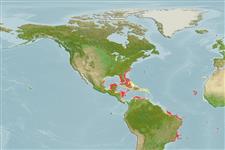>
Kurtiformes (Nurseryfishes, cardinalfishes.) >
Apogonidae (Cardinalfishes) > Apogoninae
Etymology: Apogon: Greek, a = without + Greek pogon = chin, beard (Ref. 45335).
More on author: Castelnau.
Environment: milieu / climate zone / djupintervall / distribution range
Ekologi
marina bottenlevande; djupintervall 0 - 70 m (Ref. 13121), usually 0 - 35 m (Ref. 40849). Tropical; - 24°S
Southwest Atlantic and Eastern Central Atlantic: Brazil, including Fernando de Noronha Archipelago and St. Paul's Rocks.
Size / Vikt / Age
Könsmognad: Lm ? range ? - ? cm
Max length : 10.1 cm SL hane/ej könsbestämd; (Ref. 13121)
Maximum depth from Ref. 126840. Inhabits rock pools but also found to depths of at least 50 m. Hides in holes and crevices during the day (Ref. 13121). Feeds on plankton (Ref. 40849).
Life cycle and mating behavior
Könsmognad | Reproduktion | Lek | Ägg | Fecundity | Larver
Mouthbrooders (Ref. 240). Distinct pairing during courtship and spawning (Ref. 205).
Lubbock, R. and A. Edwards, 1981. The fishes of Saint Paul's Rocks. J. Fish Biol. 18(2):135-157. (Ref. 13121)
IUCN Red List Status (Ref. 130435: Version 2024-2)
Threat to humans
Harmless
Human uses
Verktyg
Special reports
Download XML
Internet-källor
Estimates based on models
Preferred temperature (Ref.
123201): 24.7 - 28, mean 27 °C (based on 366 cells).
Phylogenetic diversity index (Ref.
82804): PD
50 = 0.5000 [Uniqueness, from 0.5 = low to 2.0 = high].
Bayesian length-weight: a=0.01445 (0.00680 - 0.03071), b=3.07 (2.89 - 3.25), in cm total length, based on LWR estimates for this (Sub)family-body shape (Ref.
93245).
Trofisk nivå (Ref.
69278): 3.4 ±0.45 se; based on food items.
Resiliens (Ref.
120179): Hög, lägsta populationsfördubblingstid mindre än 15 månader (Preliminary K or Fecundity.).
Fishing Vulnerability (Ref.
59153): Low vulnerability (10 of 100).
🛈
